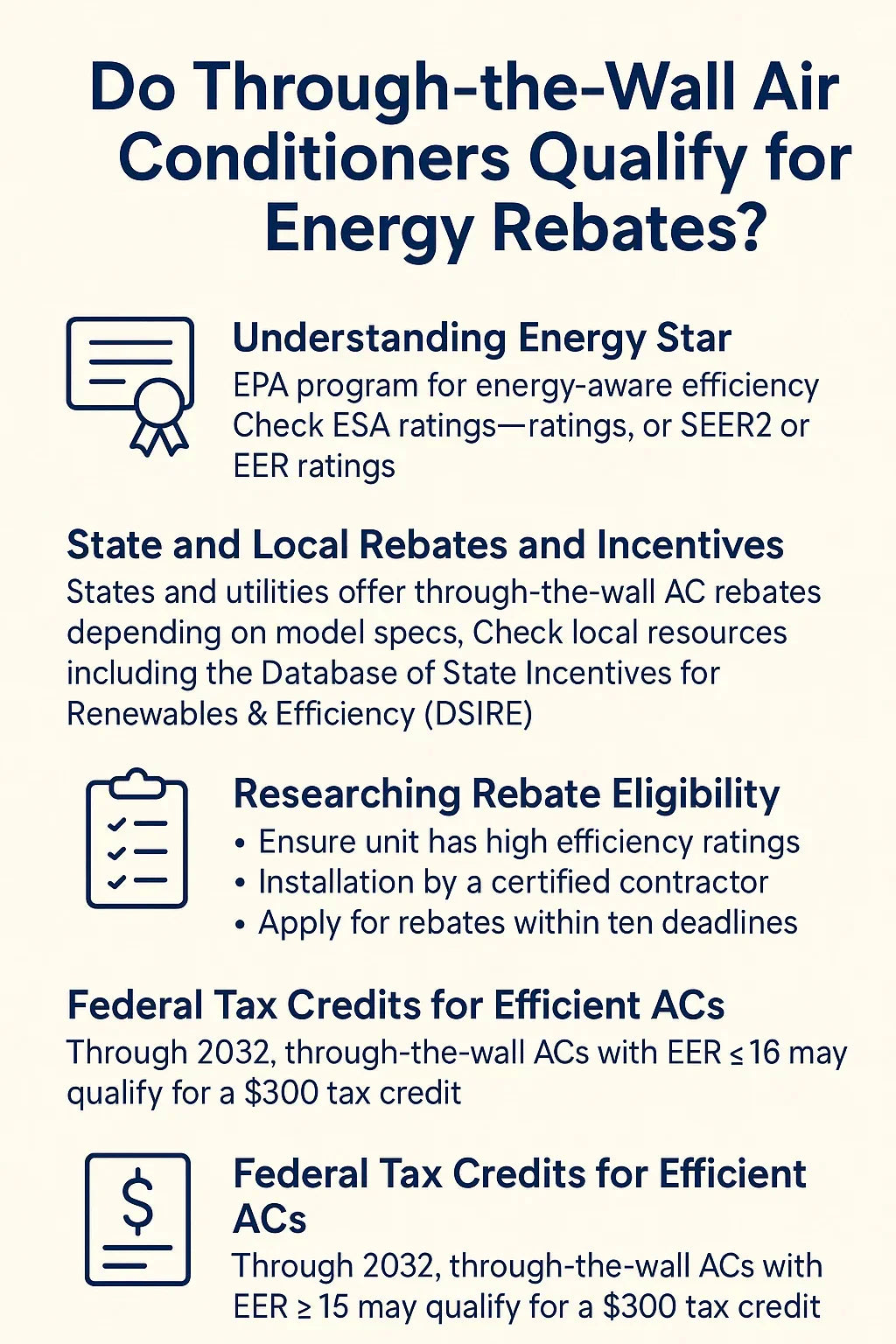Upgrading your cooling system with a through-the-wall air conditioner like the Amana 9,300 BTU PBC093J00AA is an investment in comfort and efficiency. But can it also qualify for energy rebates and tax credits to reduce your upfront costs?
This comprehensive guide explores:
✅ What rebates and tax incentives are available.
✅ Which efficiency standards your unit must meet.
✅ How to check eligibility for your state and utility rebates.
✅ Steps to claim rebates and maximize your savings.
🪟 What Are Energy Rebates for Air Conditioners?
Energy rebates are cash-back incentives or bill credits offered by federal, state, or local governments and utility companies for installing energy-efficient appliances.
These programs encourage homeowners to upgrade to efficient systems, reducing energy consumption and peak load on the grid.
Learn more about how rebates work from the U.S. Department of Energy.
✅ Types of Rebates Available
1️⃣ Federal Tax Credits
The Inflation Reduction Act of 2022 extended federal energy efficiency tax credits for qualifying HVAC systems.
2️⃣ State Energy Rebates
Many states offer additional rebates for ENERGY STAR-rated room AC units.
3️⃣ Utility Company Rebates
Local utility providers often offer rebates for high-efficiency AC systems to reduce peak energy demand.
Check for programs using the Database of State Incentives for Renewables & Efficiency (DSIRE).
🌟 Do Through-the-Wall ACs Qualify for ENERGY STAR?
ENERGY STAR is a certification for products that meet strict energy efficiency guidelines set by the EPA.
Many through-the-wall ACs qualify for ENERGY STAR, but you must verify the specific model. ENERGY STAR-rated units:
-
Use 10% less energy on average.
-
Provide efficient cooling without sacrificing performance.
Check your AC’s status on the ENERGY STAR Certified Room Air Conditioners list.
🧮 Efficiency Standards for Rebate Eligibility
Most rebate programs require: ✅ ENERGY STAR certification.
✅ Specific Energy Efficiency Ratio (EER) thresholds (often 10.0 or higher).
✅ Proper installation by a qualified contractor (for some programs).
For context, learn more about room AC standards from the Department of Energy.
🌎 State and Local Rebate Examples
Here are real rebate examples:
-
California: PG&E offers up to $50 rebates on ENERGY STAR-rated room ACs.
-
New York: Con Edison offers $30 rebates on qualifying room air conditioners.
-
Texas: Oncor offers seasonal rebates for high-efficiency AC units.
Always check your utility provider’s website for the most current rebates.
🏷️ How Much Can You Save?
While rebates on through-the-wall ACs are typically smaller than central systems, savings can add up: ✅ $30-$100 in rebates per unit. ✅ Up to $300 annually in reduced energy costs by upgrading from an inefficient unit. ✅ Potential federal tax credits (up to $300 for certain systems).
See Energy Star rebate savings estimates for detailed calculations.
📋 How to Check Your Unit’s Eligibility
✅ Verify ENERGY STAR status.
✅ Check the EER rating on your unit’s specification label or manual.
✅ Search your ZIP code on the ENERGY STAR Rebate Finder for applicable rebates.
✅ Review your state energy office and utility rebate programs.
🧾 Steps to Claim Rebates
1️⃣ Purchase an eligible ENERGY STAR-certified through-the-wall AC.
2️⃣ Keep your receipt and documentation.
3️⃣ Complete the rebate application on your utility’s or state’s website.
4️⃣ Submit proof of purchase and required documents.
5️⃣ Track your rebate status.
Rebates typically arrive within 6-12 weeks after approval.
📈 Additional Ways to Maximize Savings
✅ Proper Sizing: Avoid oversizing your unit, which wastes energy. Use the ENERGY STAR AC sizing guide.
✅ Seal and Insulate: Improving your home’s insulation and sealing air leaks will reduce your AC’s workload, lowering energy costs. See EPA’s air sealing resources.
✅ Regular Maintenance: Clean filters monthly and coils seasonally to maintain peak efficiency.
✅ Use Energy-Saving Settings: Use "Eco Mode" or programmable timers to minimize runtime.
⚡ Comparing Through-the-Wall ACs vs. Other Systems for Rebates
| System Type | Typical Rebate Range | ENERGY STAR Eligible? |
|---|---|---|
| Through-the-Wall AC | $30-$100 | Yes, some models |
| Window AC | $20-$75 | Yes |
| Central AC | $200-$600 | Yes |
| Heat Pumps | $300-$2,000 | Yes |
While rebates for through-the-wall ACs are smaller, these units offer practical efficiency gains for smaller spaces, apartments, and offices without the complexity of a full HVAC upgrade.
🛠️ Real-World Example: Amana 9,300 BTU AC
Features:
-
9,300 BTU capacity, ideal for 350-450 sq ft.
-
High EER for energy efficiency.
-
Designed for through-the-wall installation to preserve window use.
-
Potential ENERGY STAR eligibility (verify your unit’s specific status).
If eligible, you could receive up to $50 in rebates plus savings on your energy bill annually.
🧩 FAQs About Rebates for Through-the-Wall ACs
Do all through-the-wall ACs qualify for rebates?
No, only ENERGY STAR-certified units with qualifying EER ratings are typically eligible.
Can I stack rebates and tax credits?
In many cases, yes. You can combine federal tax credits with state and utility rebates if the unit qualifies.
Do I need professional installation to qualify?
Some rebate programs require professional installation, while others do not. Always check program terms.
🎯 Conclusion: Rebates Make Efficiency Affordable
Through-the-wall AC units like the Amana can qualify for energy rebates if they meet efficiency standards, helping offset your upfront investment while reducing energy bills.
By taking advantage of rebates:
✅ You lower your upfront costs.
✅ You save money on monthly energy bills.
✅ You contribute to a more sustainable energy grid.
📌 Next Steps
✅ Check your eligibility on the ENERGY STAR Rebate Finder.
✅ Compare models and efficiency ratings.
✅ Plan your purchase to align with rebate timelines.
✅ Contact your utility provider to confirm rebate details.
By leveraging rebates, you can make your AC upgrade smarter, more cost-effective, and energy-efficient
In the next topic we will know more about: What Makes Amana a Trusted Brand for Through-the-Wall ACs?







